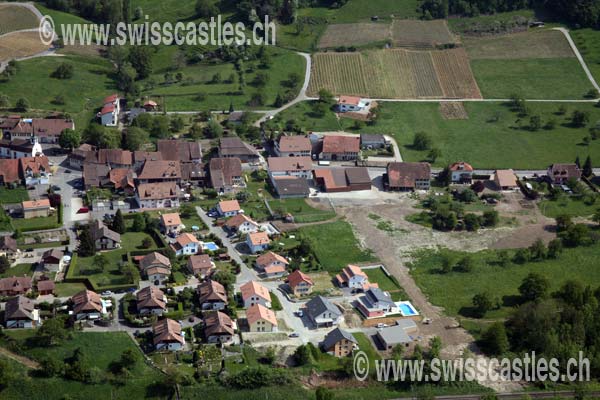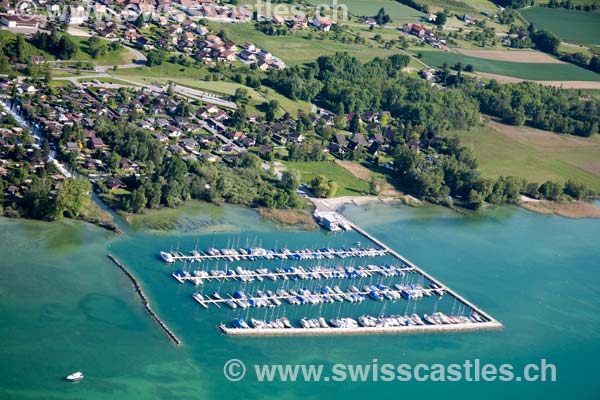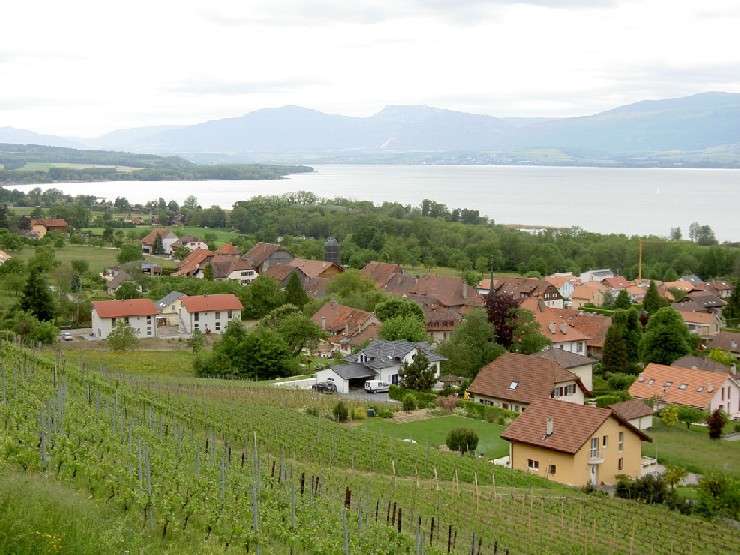Cheyres
Cheyres
Cheyres ( Freiburg Patois Tsere? / I ) is a municipality in the district Broye the canton of Fribourg in Switzerland.
Geography
Cheyres is on 454 m above sea level. Level, 6 km southwest of the district town Estavayer -le- Lac (air line). The former street line village extends on a terrace on the southern shore of Lake Neuchâtel, at the foot of the south adjacent Molassehöhen, in the northwestern Fribourg plateau.
The area of 5.2 km ² large municipality area includes a section on the southern shore of Lake Neuchâtel ( 3 km lakeshore line). In the area of Cheyres the lake has a flat up to 500 m wide riparian buffer strips, which is passed with the exception of the area below the village of a reed and swamp forest belt. These areas are part of the nature reserve of Grande Caricaie.
The communal land extends from the shoreline strips southwards over the terrace of Cheyres and over the steep slope up to the plateau ( average 630 m above sea level. M. ) of Molassehügellandes between Lake Neuchâtel and the Broyetal. The slope is divided by three short but deeply incised erosion valleys of southwest to northeast, these are the valley of the Ruisseau de la Croix (also called Le Pissiau ), the trench and the trench Combodon of Bonne Fontaine. To the southwest, the area extends in a narrow tip to the forest height from Les Rapes, on 698 m above sea level. M. the highest point of Cheyres is. This ridge is under drive from the A1 motorway, 3 km long tunnel of Arrissoules. From the municipality surface 1997 11 % came from settlements, 36 % of forest and shrubs, 45 % to agriculture and slightly more than 8% was unproductive land ( reeds ).
To Cheyres include the hamlets of Le Moulin (440 m above sea level. M. ) at the foot of the Molassehöhe northeast of the village, Champs d' amont ( 636 m above sea level. M. ) on the plateau east of the trench Combodon and extensive summer cottages near the lake and some individual farms. Neighboring communities of Cheyres are Châbles and Murist in the Canton of Fribourg and Chavannes -le- Chêne, Rovray and Yvonand in the canton of Vaud.
Population
With 1242 inhabitants ( 31 December 2012) Cheyres one of the smaller municipalities in the canton of Fribourg. Of the 86.8 % inhabitants are French-speaking, German-speaking 9.6 % and 1.5 % speak Portuguese (as of 2000). The population of Cheyres amounted in 1850 to 381 residents in 1900 to 403 inhabitants. During the 20th century, the population fluctuated always in the range 350-420 inhabitants. Only since 1980 (380 inhabitants), a rapid population growth was associated with a doubling of the population recorded in 20 years.
Economy
Cheyres was until the second half of the 20th century, mainly coined by farming village. Even today, the crop and livestock farming have an important place in the economic structure of the population. There are also above the village some smaller wine regions and a significant number of fruit trees, especially cherry trees. The distillery was founded in 1894 Michel.
More jobs are available in the local retail and service sectors, including Building companies and machine shops. In recent decades, the village has developed thanks to its attractive location and into a residential community. Many workers are therefore commuters who work mainly in the regions Estavayer -le- Lac and Yverdon- les- Bains.
Tourism
Since the 1960s Cheyres has made efforts to boost tourism. In the shallow zone near the lake numerous holiday and weekend houses were built, and there are a camping, sports and leisure facilities and a opened in 2006 port.
Traffic
The community is conveniently comparatively quite well developed. It lies on the main road from Yverdon- les- Bains to Estavayer -le- Lac. On 1 February 1877, the railway line from Yverdon to Payerne was taken with a station in Cheyres in operation. There are bus individual Buskurse the Transports publics Fribourgeois of Estavayer -le- Lac to Cheyres.
History
Cheyres can look back on a very long urban tradition. On the shores of Lake Neuchâtel remains of riparian settlements and pile dwellings were discovered from the Neolithic period and the Bronze Age. Even during the Roman period here was a storage place.
The first written mention of the village was carried out in 1230 under the name Cheres; by 1233 the name Chieres is preserved. The place name is derived from the Latin villa Carias and probably goes back to the feminine Caria of the Roman personal name Carius.
In the Middle Ages Cheyres was initially part of the rule Font La Molière, it was formed by the division in 1441 its own rule, which also included Bollion and Seiry. Later Cheyres has undergone numerous changes of ownership: After 1536 Bern had conquered the Vaud country, it came under the rule of Freiburg and the Bailiwick Estavayer was assigned. The rule Cheyres came in 1560 at the Lausanne family Praroman and from 1704 through the purchase of Freiburg, where it was raised to its own bailiwick. Ecclesiastical belonged Cheyres until the Reformation in 1536 to the parish Yvonand, since it formed a separate parish.
After the collapse of the ancien régime (1798 ) was one Cheyres during the Helvetic Republic and the subsequent time to the district Estavayer and was incorporated in 1848 in the District Broye.
Attractions
The parish church of Saint -Nicolas is in the core back to the late 15th century, but was virtually rebuilt in the years 1749-1752. They possessed a cry Madonna from the 14th century, which was stolen in 1976 and 2000, replaced by a copy. The Chapel of Notre- Dame de Bonne Fontaine in the forest east of the village was long an important place of pilgrimage.
Also standing next to the church of Cheyres castle originally dates from the 15th century, but fell apart in the 18th century ruin. It was rebuilt in 1772-74, was the residence of the bailiff employed by Freiburg and has a richly sculptured pediment bearing the arms of Freiburg. In the center some characteristic farmhouses from the 17th to 19th centuries have been preserved.









